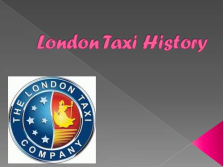| Слайд №2 |
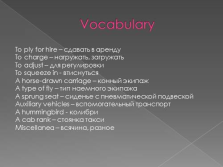 |
Vocabulary
To ply for hire – сдавать в аренду
To charge – нагружать, загружать
To adjust – для регулировки
To squeeze in — втиснуться
A horse-drawn carriage – конный экипаж
A type of fly – тип наемного экипажа
A sprung seat – сиденье с пневматической подвеской
Auxiliary vehicles – вспомогательный транспорт
A hummingbird — колибри
A cab rank – стоянка такси
Miscellanea – всячина, разное
|
| Слайд №3 |
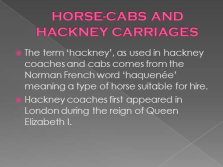 |
HORSE-CABS AND HACKNEY CARRIAGES
The term ‘hackney’, as used in hackney coaches and cabs comes from the Norman French word ‘haquen?e’ meaning a type of horse suitable for hire.
Hackney coaches first appeared in London during the reign of Queen Elizabeth I. |
| Слайд №4 |
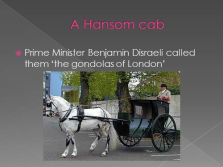 |
A Hansom cab
Prime Minister Benjamin Disraeli called them ‘the gondolas of London’ |
| Слайд №5 |
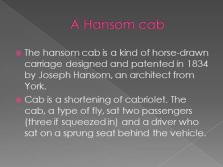 |
A Hansom cab
The hansom cab is a kind of horse-drawn carriage designed and patented in 1834 by Joseph Hansom, an architect from York.
Cab is a shortening of cabriolet. The cab, a type of fly, sat two passengers (three if squeezed in) and a driver who sat on a sprung seat behind the vehicle. |
| Слайд №6 |
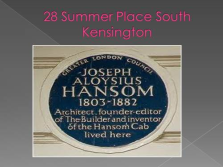 |
28 Summer Place South Kensington |
| Слайд №7 |
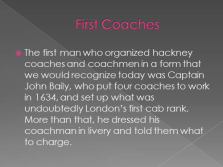 |
First Coaches
The first man who organized hackney coaches and coachmen in a form that we would recognize today was Captain John Baily, who put four coaches to work in 1634, and set up what was undoubtedly London’s first cab rank. More than that, he dressed his coachman in livery and told them what to charge. |
| Слайд №8 |
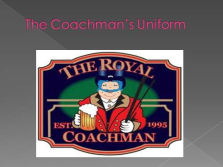 |
The Coachman’s Uniform |
| Слайд №9 |
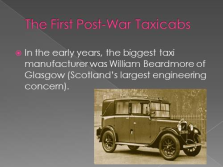 |
The First Post-War Taxicabs
In the early years, the biggest taxi manufacturer was William Beardmore of Glasgow (Scotland’s largest engineering concern). |
| Слайд №10 |
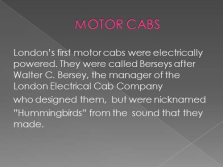 |
MOTOR CABS
London’s first motor cabs were electrically powered. They were called Berseys after Walter C. Bersey, the manager of the London Electrical Cab Company
who designed them, but were nicknamed
”Hummingbirds” from the sound that they made. |
| Слайд №11 |
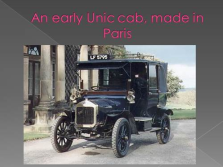 |
An early Unic cab, made in Paris |
| Слайд №12 |
 |
A new Austin cab, “the High Lot”
An Austin 12/4 Low Loader taxi from the mid-1930s. Cabs could be found in many
different colours
before the 1940s
and fleets would
have their own
colour. |
| Слайд №13 |
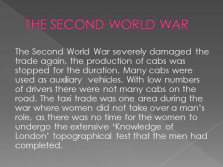 |
THE SECOND WORLD WAR
The Second World War severely damaged the trade again, the production of cabs was stopped for the duration. Many cabs were used as auxiliary vehicles. With low numbers of drivers there were not many cabs on the road. The taxi trade was one area during the war where women did not take over a man’s role, as there was no time for the women to undergo the extensive ‘Knowledge of London’ topographical test that the men had completed. |
| Слайд №14 |
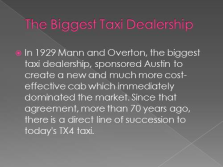 |
The Biggest Taxi Dealership
In 1929 Mann and Overton, the biggest taxi dealership, sponsored Austin to create a new and much more cost-effective cab which immediately dominated the market. Since that agreement, more than 70 years ago, there is a direct line of succession to today’s TX4 taxi. |
| Слайд №15 |
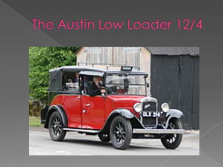 |
The Austin Low Loader 12/4 |
| Слайд №16 |
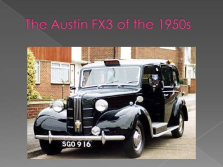 |
The Austin FX3 of the 1950s |
| Слайд №17 |
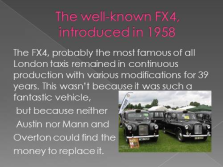 |
The well-known FX4, introduced in 1958
The FX4, probably the most famous of all London taxis remained in continuous production with various modifications for 39 years. This wasn’t because it was such a fantastic vehicle,
but because neither
Austin nor Mann and
Overton could find the
money to replace it. |
| Слайд №18 |
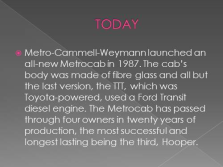 |
TODAY
Metro-Cammell-Weymann launched an all-new Metrocab in 1987. The cab’s body was made of fibre glass and all but the last version, the TTT, which was Toyota-powered, used a Ford Transit diesel engine. The Metrocab has passed through four owners in twenty years of production, the most successful and longest lasting being the third, Hooper. |
| Слайд №19 |
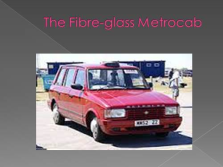 |
The Fibre-glass Metrocab |
| Слайд №20 |
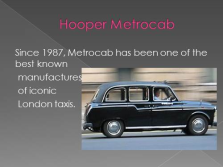 |
Hooper Metrocab
Since 1987, Metrocab has been one of the best known
manufactures
of iconic
London taxis. |
| Слайд №21 |
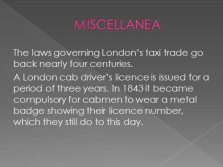 |
MISCELLANEA
The laws governing London’s taxi trade go back nearly four centuries.
A London cab driver’s licence is issued for a period of three years. In 1843 it became compulsory for cabmen to wear a metal badge showing their licence number, which they still do to this day. |
| Слайд №22 |
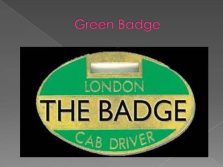 |
Green Badge |
| Слайд №23 |
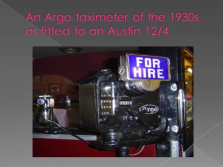 |
An Argo taximeter of the 1930s, as fitted to an Austin 12/4 |
| Слайд №24 |
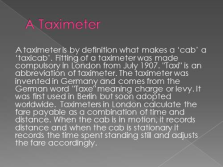 |
A Taximeter
A taximeter is by definition what makes a ‘cab’ a ‘taxicab’. Fitting of a taximeter was made compulsory in London from July 1907. «Taxi» is an abbreviation of taximeter. The taximeter was invented in Germany and comes from the German word «Taxe» meaning charge or levy. It was first used in Berlin but soon adopted worldwide. Taximeters in London calculate the fare payable as a combination of time and distance. When the cab is in motion, it records distance and when the cab is stationary it records the time spent standing still and adjusts the fare accordingly. |
| Слайд №25 |
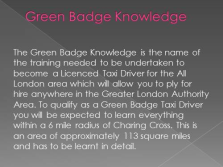 |
Green Badge Knowledge
The Green Badge Knowledge is the name of the training needed to be undertaken to become a Licenced Taxi Driver for the All London area which will allow you to ply for hire anywhere in the Greater London Authority Area. To qualify as a Green Badge Taxi Driver you will be expected to learn everything within a 6 mile radius of Charing Cross. This is an area of approximately 113 square miles and has to be learnt in detail. |
| Слайд №26 |
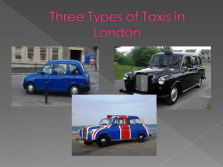 |
Three Types of Taxis in London |
| Слайд №27 |
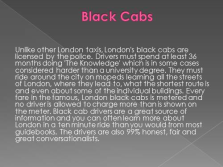 |
Black Cabs
Unlike other London taxis, London’s black cabs are licensed by the police. Drivers must spend at least 36 months doing ‘The Knowledge’ which is in some cases considered harder than a university degree. They must ride around the city on mopeds learning all the streets of London, where they lead to, what the shortest route is and even about some of the individual buildings. Every fare in the famous, London black cabs is metered and no driver is allowed to charge more than is shown on the meter. Black cab drivers are a great source of information and you can often learn more about London in a ten minute ride than you would from most guidebooks. The drivers are also 99% honest, fair and great conversationalists.
|
| Слайд №28 |
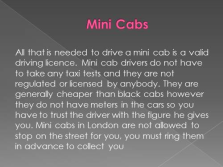 |
Mini Cabs
All that is needed to drive a mini cab is a valid driving licence. Mini cab drivers do not have to take any taxi tests and they are not regulated or licensed by anybody. They are generally cheaper than black cabs however they do not have meters in the cars so you have to trust the driver with the figure he gives you. Mini cabs in London are not allowed to stop on the street for you, you must ring them in advance to collect you |
| Слайд №29 |
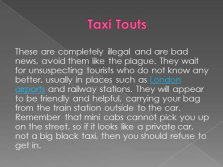 |
Taxi Touts
These are completely illegal and are bad news, avoid them like the plague. They wait for unsuspecting tourists who do not know any better, usually in places such as London airports and railway stations. They will appear to be friendly and helpful, carrying your bag from the train station outside to the car. Remember that mini cabs cannot pick you up on the street, so if it looks like a private car, not a big black taxi, then you should refuse to get in. |
| Слайд №30 |
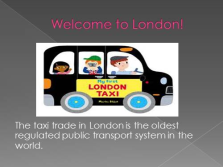 |
Welcome to London!
The taxi trade in London is the oldest regulated public transport system in the world. |
| Слайд №31 |
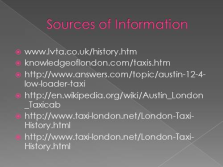 |
Sources of Information
www.lvta.co.uk/history.htm?
knowledgeoflondon.com/taxis.htm
http://www.answers.com/topic/austin-12-4-low-loader-taxi
http://en.wikipedia.org/wiki/Austin_London_Taxicab
http://www.taxi-london.net/London-Taxi-History.html
http://www.taxi-london.net/London-Taxi-History.html
|
